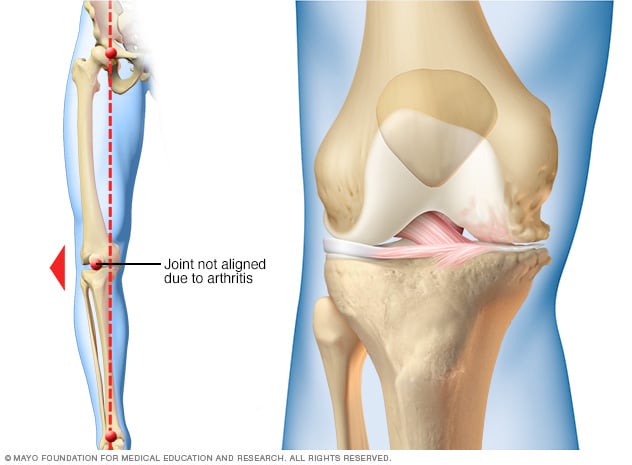Brace Knee pad
A brace might help reduce pain by shifting your weight off the most damaged portion of your knee. Wearing a brace can improve your ability to get around and help you walk farther comfortably.
Overview
A knee brace is one tool in managing the discomfort of knee osteoarthritis. A brace might help reduce pain by shifting your weight off the most damaged portion of your knee. Wearing a brace can improve your ability to get around and help you walk farther comfortably.
There are various types of braces used for knee arthritis. An unloader brace is the type that shifts weight off the affected portion of the knee.
Why it's done
Osteoarthritis is a complex condition involving the entire joint. It's mainly known as a wear-and-tear type of arthritis that commonly affects the knees of older people. The disease frequently affects one side of your knee more than the other. This unequal damage can cause your knee to align imperfectly (malalignment), which can make you look knock-kneed or bowlegged.
As the damage progresses, this malalignment worsens. A knee brace can take pressure off the part of your joint most affected by osteoarthritis and help relieve pain. If your knee feels like it might buckle when you put weight on it, a knee brace can also help you stand and move around with more confidence.
During your knee brace fitting
You might adjust to wearing a knee brace more quickly if you start with a good fit, which is the goal of working with an orthotist. During the fitting, the orthotist might:
- Examine your knee
- Ask about your history of knee arthritis and the symptoms that trouble you most
- Ask what activities you hope to increase by wearing a knee brace
- Ask you to walk a few paces to show how your knee functions
- Take several measurements of your leg to determine what size you need
- Discuss the pros and cons of off-the-shelf and custom braces
- Explain how knee brace designs differ from each other
- Have you try various knee braces to determine what style feels best and is easiest for you to use
After your knee brace fitting
With help from the orthotist, you'll learn how to put on and take off the knee brace and how to tell whether it needs adjustment. You'll likely walk around to try out your brace.
Follow the orthotist's or your doctor's instructions about when to wear your knee brace. Some people wear their knee braces only during continuous activity, such as walking or playing certain sports. Other people find it helpful to wear the brace most of the day.
Results
Osteoarthritis can make you feel as if your knee is about to give out. As a result, you might automatically guard your knee and avoid putting weight on it. If worn consistently, a knee brace can offer some stability and increase your confidence in your knee.
Some evidence suggests that knee braces can help reduce symptoms and improve function in people who have knee osteoarthritis. More-recent studies, however, have demonstrated less of a benefit. Many people stop wearing knee braces because they don't get enough knee pain relief or because of complications, such as poor fit or because they don't like the way the brace looks.
Weight loss and exercise — particularly exercises that strengthen the thigh muscles — are considered the best first line treatments for knee osteoarthritis.


